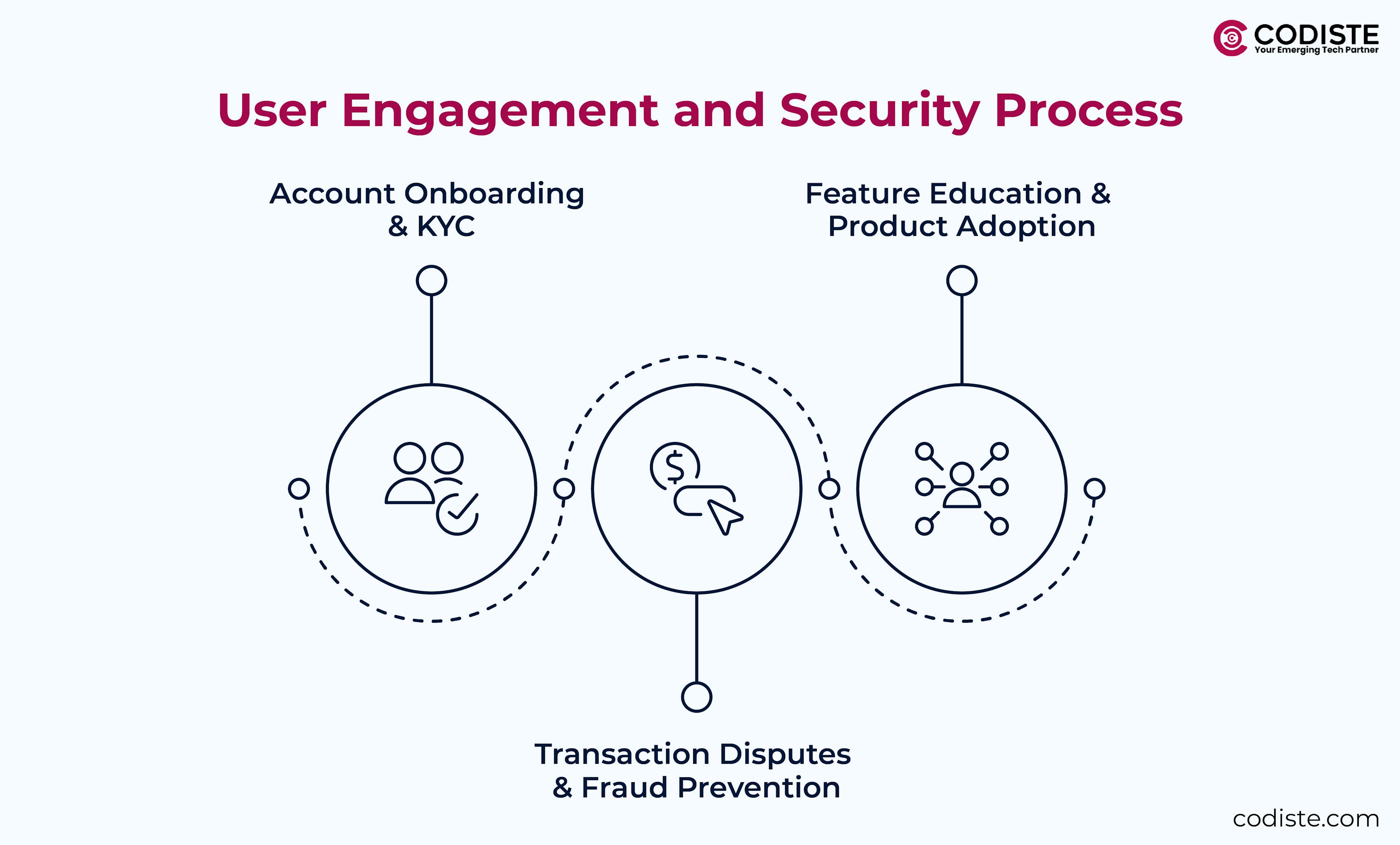
,
TL;DR
- AI chatbots in customer service reduce neobank support costs by 20-40% while improving response times and user satisfaction
- Customer service automation works best for high-volume, routine queries like account questions, transaction disputes, and feature education
- AI-powered customer service systems require proper integration with core banking platforms, security frameworks, and compliance requirements
- Implementation typically shows 15-25% deflection rates initially, scaling to 60-80% for targeted query types within 12 months
- Digital banking automation success depends on seamless human handoff design and continuous AI model improvement
- Neobank customer experience improvements through AI chatbots directly correlate with reduced churn and higher user engagement scores
- ROI becomes measurable within 3-6 months through reduced support costs and improved operational efficiency
Many times, businesses face a conundrum, and this is not something new either; it's the common old problem of support tickets piling up and response times stretching into hours, and every delayed interaction chipping away at user trust.
Here's the thing: AI chatbots in customer service aren't just another tech trend for the neobanking industry; in fact, they're becoming essential infrastructure. 48% of US bank executives plan to use generative AI to enhance customer-facing chatbots, and the reasons are crystal clear: operational efficiency, cost control, and user satisfaction at scale.
This guide breaks down exactly how customer service automation can transform your neobank's support operations without sacrificing the personalized experience your users expect.
The Real Cost of Manual Support in Neobanks
Let's talk numbers. Neobank customer acquisition costs range from $5 to $15, but retaining those users often costs more when support experiences fall short. Every frustrated user who churns because of slow support response represents lost LTV that could reach thousands of dollars.
Traditional support models create three critical bottlenecks:
- Linear scaling costs: Each new thousand users requires proportional support staff
- Response time degradation: Peak hours crush even well-staffed teams
- Inconsistent quality: Human agents vary in knowledge, tone, and problem-solving speed
Neobanks generated over $40 billion in global revenue in 2023, but those succeeding long-term are the ones solving support scalability early.
Why Generic Chatbots Fail in Financial Services
You've probably tested basic chatbots before. Maybe you built decision trees, programmed FAQ responses, or deployed rule-based systems that left users more frustrated than helped.
Traditional chatbots vs AI-powered customer service represent a fundamental shift in capability:
Traditional Rule-Based Chatbots:
- Follow predetermined conversation paths
- Break when users ask unexpected questions
- Require constant manual updates for new scenarios
- Can't understand context or intent variations
AI-Powered Neobanks Chatbot Systems:
- Process natural language with context awareness
- Learn from interactions to improve responses
- Handle complex, multi-step financial queries
- Integrate with your existing banking systems
PayPal experienced a 20% decrease in customer support costs and 25% increase in user engagement after implementing AI chatbots. The difference isn't just efficiency; it's user experience quality.
Real-World AI Chatbot Applications in Neobanking

Let's break down specific use cases where neobank customer experience gets dramatically improved through intelligent automation:
1. Account Onboarding & KYC Support
Your onboarding flow probably generates the most support tickets. Users get stuck on document uploads, verification steps, or account activation.
AI automation handles:
- Document requirement clarification
- Upload troubleshooting guidance
- Verification status updates
- Account activation confirmation
Result: Faster activation rates, fewer abandonment points.
2. Transaction Disputes & Fraud Prevention
Financial disputes require nuanced handling that traditional chatbots can't manage.
Advanced chatbots provide:
- Initial dispute intake and categorization
- Evidence collection guidance
- Timeline expectations and status updates
- Escalation to human agents when complexity requires it
3. Feature Education & Product Adoption
Users often underutilize neobank features simply because they don't understand them.
AI-driven support offers:
- Personalized feature recommendations
- Step-by-step usage guidance
- Integration with other financial tools
- Proactive tips based on user behavior patterns
Read more:
AI in Fintech: The Ultimate Guide for Innovators
AI in Banking: Applications, Benefits and Examples
AI in Credit Scoring: Unlocking Lending for Underbanked Markets
Choosing the Top 10 Fintech Development Companies for AI-Driven Growth
How Generative AI is Changing Financial Services
AI-Powered Fraud Detection: What Fintech CTOs Need to Know
Neobank 3.0: How AI Is Redefining Digital Banking in Fintech
The Basics of Selecting the Right Fintech App Development Partner
Neo Banking vs Traditional Banks: Who Wins the Fintech Innovation Game?
The Technology That Powers Neo-Banking Chatbots
Digital banking automation requires more than conversational AI. Here's what makes the difference:
Natural Language Processing (NLP) Layers:
- Intent recognition: Understanding what users want
- Entity extraction: Identifying account numbers, amounts, and dates
- Context maintenance: Remembering conversation history
- Sentiment analysis: Detecting frustration for human handoff
Natural language processing in banking integration points:
- Core banking systems for real-time account data
- KYC/AML databases for compliance checks
- Transaction history for dispute context
- Product catalogs for feature explanations
Security & Compliance Framework:
- End-to-end encryption for sensitive data
- PCI DSS compliance for payment information
- Audit trails for regulatory requirements
- Multi-factor authentication triggers
78% of customer service agents agree that customers are open to being served by AI, but only when security standards meet banking expectations.
Ready to Transform Your Neobank's Support Experience?
Implementation Frameworks: Build vs Buy vs Integrate
You're facing a classic fintech decision: internal development, third-party integration, or hybrid approach. Here's how to evaluate your options:
Build In-House
Best for: Large neobanks with significant AI/ML teams
Pros:
- Complete customization control
- Tight integration with proprietary systems
- No vendor dependency
Cons:
- 12-18 month development timeline
- Requires specialized AI talent
- Ongoing maintenance overhead
Third-Party Integration
Best for: Growing neobanks prioritizing speed-to-market
Pros:
- 2-8 week deployment timeline
- Pre-built financial services features
- Regular updates and improvements
Cons:
- Customization limitations
- Ongoing licensing costs
- Integration complexity with legacy systems
Hybrid Approach
Best for: Established neobanks with specific differentiation needs
Pros:
- Custom core logic with proven infrastructure
- Faster than full build-out
- Scalable architecture
KPI’s for Measuring Success
Automated customer support success isn't just about deflection rates. Track metrics that correlate with business outcomes:
Operational Metrics:
- Resolution rate: Percentage of issues solved without human intervention
- Average handling time: From initial query to resolution
- Escalation rate: When chatbots appropriately hand off to humans
- Cost per resolution: Total support costs divided by resolved tickets
User Experience Metrics:
- Chatbot customer satisfaction (CSAT): Post-interaction ratings
- User engagement: Return usage of chatbot features
- Task completion rate: Successfully finished interactions
- Net Promoter Score (NPS): Overall satisfaction impact
Business Impact Metrics:
- Support cost reduction: Percentage decrease in per-user support costs
- Response time improvement: Average time to first response
- Agent productivity: Human agent capacity for complex issues
- Revenue protection: Retained users who might have churned due to support friction
The average chatbot conversation lasts 1 minute 38 seconds versus 15 minutes 21 seconds for live chat handovers, and that efficiency compounds quickly across thousands of interactions.
Common Implementation Pitfalls (And How to Avoid Them)
1: Over-Automating Too Soon
Problem: Trying to automate every support interaction from day one
Solution: Start with high-volume, low-complexity queries. Gradually expand the scope based on performance data.
2: Ignoring Human Handoff Design
Problem: Clunky transitions from bot to human agents lose context
Solution: Build seamless escalation paths that transfer conversation history and user context.
3: Neglecting Ongoing Training
Problem: AI models degrade without regular updates and new data
Solution: Establish feedback loops that continuously improve responses based on user interactions.
4: Compliance Afterthoughts
Problem: Deploying chatbots without proper regulatory consideration
Solution: Build compliance checkpoints into every automated workflow from the start.
ROI Timeline: What to Expect
Month 1-2: Initial Deployment
- Basic FAQ automation live
- 15-25% deflection rate for simple queries
- User adoption typically starts slow
Month 3-6: Optimization Phase
- 40-60% deflection rate as AI learns patterns
- Noticeable reduction in support ticket volume
- User satisfaction scores stabilize or improve
Month 6-12: Scaling Impact
- 60-80% deflection rate for targeted query types
- Measurable cost savings vs. linear hiring
- Human agents focus on high-value, complex issues
Post Year 1: Strategic Advantage
- Personalized banking experience through AI insights
- Proactive support based on user behavior patterns
- Competitive differentiation in user engagement neobank metrics
Compliance and Legal Considerations
AI Fintech Solutions Neobank implementations must navigate complex compliance requirements. Key considerations include:
Data Privacy Requirements:
- GDPR compliance for EU users
- CCPA requirements for California residents
- Financial data protection standards
- User consent management
Fintech Risk Management with AI:
- Model governance frameworks
- Bias testing and mitigation
- Explainable AI for regulatory audits
- Consumer protection compliance
Operational Resilience:
- System availability requirements
- Disaster recovery planning
- Third-party vendor management
- Incident response procedures
Working with experienced AI banking support providers helps navigate these complexities without slowing deployment.
How to Make the Right AI Adoption Decision
Your support team's current pain points won't solve themselves. The question isn't whether to implement AI-powered customer service, it's when and how.
Consider these decision criteria:
Implement AI chatbots now if:
- Support costs are growing faster than revenue
- Response times regularly exceed user expectations
- Your team spends significant time on repetitive queries
- You're planning significant user base growth
Wait and optimize current systems if:
- Support costs are manageable and predictable
- User satisfaction scores consistently meet targets
- You lack internal technical resources for implementation
- Regulatory uncertainty creates compliance risks
Conclusion
Machine learning in customer service and generative AI in fintech aren't future possibilities, they're competitive necessities. The neobanks winning market share today are the ones delivering instant, accurate, 24/7 digital banking help that users prefer over traditional support channels.
Your users expect banking to be seamless, instant, and available whenever they need it. AI automation for neobanks makes that expectation achievable without destroying your unit economics.
If you're ready to explore how neobank fintech leaders are scaling support without scaling costs, it's time to evaluate AI-powered solutions seriously. With Codiste the technology is proven, the ROI is measurable, and your users are waiting for the experience upgrade. Book A Call Now



5 Key Use Cases of MCP in Fintech: Payments, Lending, KYC & More
Know more
How AI Voice Agents Help Businesses Scale Customer Support Effortlessly
Know more
